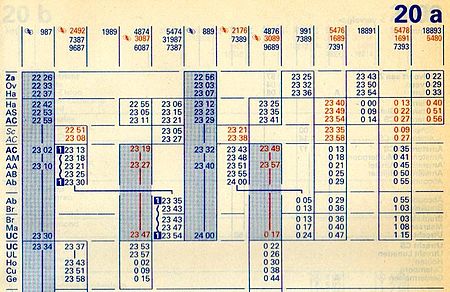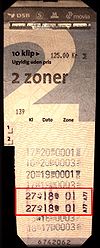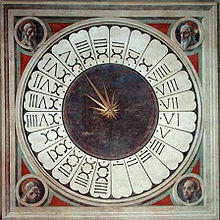- 24-hour clock
-
"24H" redirects here. For the Canadian newspaper chain, see 24H (newspaper).
24-hour clock 12-hour clock 00:00 12:00 a.m.
(start of day)
"12 midnight"01:00 1:00 a.m. 02:00 2:00 a.m. 03:00 3:00 a.m. 04:00 4:00 a.m. 05:00 5:00 a.m. 06:00 6:00 a.m. 07:00 7:00 a.m. 08:00 8:00 a.m. 09:00 9:00 a.m. 10:00 10:00 a.m. 11:00 11:00 a.m. 12:00 12:00 p.m.
12 noon13:00 1:00 p.m. 14:00 2:00 p.m. 15:00 3:00 p.m. 16:00 4:00 p.m. 17:00 5:00 p.m. 18:00 6:00 p.m. 19:00 7:00 p.m. 20:00 8:00 p.m. 21:00 9:00 p.m. 22:00 10:00 p.m. 23:00 11:00 p.m. 24:00 ("12 midnight")*
(end of day)* See "Confusion
at noon and midnight"The 24-hour clock is a convention of time keeping in which the day runs from midnight to midnight and is divided into 24 hours, indicated by the hours passed since midnight, from 0 to 23. This system is the most commonly used time notation in the world today.[1] The 12-hour clock is however still dominant in a handful of countries,[1] particularly in Australia, Canada (except Quebec), India, Iran, the Philippines, Pakistan, the United Kingdom and the United States, and some Latin American nations. The 24-hour notation is also popularly referred to as military time or astronomical time in the United States and Canada.[2] It is also the international standard notation of time (ISO 8601).[3] In the practice of medicine, the 24-hour clock is generally used in documentation of care as it prevents any ambiguity as to when events occurred in a patient's medical history.
Contents
Description
A time of day is written in the 24-hour notation in the form hh:mm (for example 01:23) or hh:mm:ss (for example, 01:23:45), where hh (00 to 23) is the number of full hours that have passed since midnight, mm (00 to 59) is the number of full minutes that have passed since the last full hour, and ss (00 to 59) is the number of seconds since the last full minute. In the case of a leap second, the value of ss may extend to 60. A leading zero is added for numbers under 10. This zero is optional for the hours, but very commonly used in computer applications, where many specifications require it (for example, ISO 8601). Where subsecond resolution is required, the seconds can be a decimal fraction, that is, the fractional part follows a decimal dot or comma, as in 01:23:45.678. The most commonly used separator symbol between hours, minutes and seconds is the colon, which is also the symbol used in ISO 8601. In the past, some European countries used the dot on the line as a separator, but most national standards on time notation have since then been changed to the international standard colon. In some contexts (e.g., U.S. military, some computer protocols), no separator is used (e.g., 2359) and in some jurisdictions (France and Quebec) the letter h (for "heure") is used when indicating hours and minutes only (18h45).
Midnight 00:00 and 24:00
In the 24-hour time notation, the day begins at midnight, 00:00, and the last minute of the day begins at 23:59. Where convenient, the notation 24:00 may also be used to refer to midnight at the end of a given date—that is, 24:00 of one day is the same time as 00:00 of the following day.
The notation 24:00 mainly serves to refer to the exact end of a day in a time interval. A typical usage is giving opening hours ending at midnight, e.g. "00:00–24:00", "07:00–24:00". Similarly, some railway timetables show 00:00 as departure time and 24:00 as arrival time. Legal contracts often run from the start date at 00:00 till the end date at 24:00. It should be stressed, however, that "24:00" is a notation for the purposes of clarity and does not represent the display seen on the face of a clock.
While the 24-hour notation does unambiguously distinguish between midnight at the start (00:00) and end (24:00) of any given date, there is no such commonly accepted distinction among users of the 12-hour notation. Therefore, style guides and military communication regulations in some English-speaking countries discourage the use of 00:00 and 24:00 even in the 24-hour notation, and recommend reporting times near midnight as 23:59 or 00:01 instead, to avoid misunderstandings when such times are converted into the 12-hour notation later.[4]
Time-of-day notations beyond 24:00 (such as 24:01 or 25:59 instead of 00:01 or 01:59) are not commonly used and not covered by the relevant standards. However, they have been observed occasionally in some special contexts in Japan and Hong Kong where business hours extend beyond midnight, such as broadcast-television production. They also appear in some public-transport applications, such as Google's General Transit Feed Specification file format or some ticketing systems (e.g. in Copenhagen).
Digital clocks and watches using the 24-hour system usually show 00:00 at midnight. On some European brands of domestic appliance, such as ovens and microwaves, midnight is indicated by 24:00, continuing with 00:01.
Computer support
In most countries, computers by default show the time in 24-hour notation. For example, Microsoft Windows activates the 12-hour notation by default only if a computer's language and region settings are:
- Albanian
- Chinese (Singapore and Taiwan)
- English (Australia, Belize, Canada, Caribbean, Jamaica, New Zealand, Philippines, Trinidad, South Africa, United States, and Zimbabwe)
- Greek
- Korean
- Spanish (Mexico and parts of South America)
- Swahili
Usually, users can easily switch to the 24-hour notation in such locales, without affecting any of the other regional preferences.
Military time
In Canada and the United States, the term "military time" is a synonym for the 24-hour clock.[5] In these regions, the time of day is customarily given almost exclusively using the 12-hour clock notation, which counts the hours of the day as 12, 1, ..., 11 with suffixes "a.m." and "p.m." distinguishing the two diurnal repetitions of this sequence. The 24-hour clock is commonly used there only in some specialist areas (military, aviation, navigation, tourism, meteorology, astronomy, computing, logistics, emergency services, hospitals), where the ambiguities of the 12-hour notation are deemed too inconvenient, cumbersome, or outright dangerous, with the military's use being the most famous example. The term "military time" has no particular meaning in most other regions of the world, where the 24-hour clock has long become a common element of every-day civilian life.
In the United States military, military time is similar to the 24-hour clock notation, with the exception that the colon is omitted and the time on the hours is often spoken as its decimal value. For instance, 6:00 a.m. would become 0600, and would be spoken "zero six hundred" (for example, when said face-to-face), "oh six hundred" (colloquial and not strictly correct, as military communication protocols specify the word "zero" rather than "oh"), or "zero six zero zero" (for example, where clarity is needed when specifying the time over a radio or sound-powered telephone). However, none of these formatting or pronunciation details is exclusively military and all are common in the technical contexts in which the 24-hour clock is used in English-speaking countries.
There are some differences between military usage and other twenty-four-hour time systems:
- Written military time does not usually include a time separator (for example, "0340" is more common than the civilian "03:40").
- Leading zeros, always written out by the military, are often also spoken in military usage, so 5:43 a.m. is often spoken "zero five forty-three" (military), as opposed to "five forty-three" (civilian).
- Military timestamps on messages have the time zone where applicable appended; in a civilian setting, this would be redundant. Military time zones are lettered and thus given word designations via the NATO phonetic alphabet. For example, 6:00AM Eastern Standard Time (GMT-5) would be written "0600R" and spoken, "zero six hundred Romeo".
- Local time is specifically designated in the military as zone J or "Juliet". A time of "1200J" ("twelve hundred Juliet") corresponds to noon local time.
- Greenwich Mean Time (or Coordinated Universal Time) is designated as zone Z or "Zulu". Usage of Z time is common in operations crossing multiple time zones.
History
The 24-hour time system has been used for centuries, primarily by scientists, astronomers, navigators, and horologists. There are many surviving examples of clocks built using the 24-hour system, including the famous Orloj in Prague, and the Shepherd gate clock at Greenwich.
At the International Meridian Conference in 1884, Sandford Fleming proposed:
That this universal day is to be a mean solar day; is to begin for all the world at the moment of mean midnight of the initial meridian, coinciding with the beginning of the civil day and date of that meridian; and is to be counted from zero up to twenty-four hours.
This resolution was adopted by the conference.[6]
According to a report in the London Times in 1886, the 24-hour clock was in use on the Canadian Pacific Railway train at Port Arthur.[7]
The earliest country to introduce the 24-hour system nationally was Italy, in 1893.[8] Other European countries followed: France adopted it in 1912 (the French army in 1909), followed by Denmark (1916), and Greece (1917). By 1920, Spain, Portugal, Belgium, and Switzerland had switched, followed by Turkey (1925), and Germany (1927). By the early 1920s, many countries in Latin America had also adopted the 24-hour clock. Some of the railways in India had switched before the outbreak of the war.[8]
During the First world war, the British Navy adopted the 24-hour clock in 1915, and the Allied armed forces followed soon after,[8] with the British Army switching officially in 1918.[9] The Canadian military first started to use the 24-hour clock in late 1917.[10] In 1920, the US Navy was the first US organization to adopt the system; the US Army didn't officially adopt the 24-hour clock until the Second world war, on July 1 1942.[11]
In Britain, the use of the 24-hour clock in daily life has grown steadily since the beginning of the 20th century, although attempts to make the system official failed more than once.[12] In 1934, the BBC switched to the 24-hour clock for broadcast announcements and programme listings. The experiment was halted after five months following a lack of enthusiasm from the public, and the BBC has used the 12-hour clock ever since.[12] In the same year, the US airlines Pan American and Western Airlines both adopted the 24-hour clock.[13]
British Rail and London Transport switched to the 24-hour clock for timetables in 1964.[12]
In 2005, BBC Weather television forecasts used the 12-hour notation for several months after its graphical revamp. After complaints from the public, however, this was switched to 24-hour notation.[citation needed]
Criticism and practical problems
The 24-hour clock lacks some notable features:
- It does not correspond to analogue clocks, most of which display only 12 hours. It could be argued that this is more accurately a deficiency of analogue clocks, which only account for 12 hours of a 24-hour day.
In some countries time is usually pronounced in 12-hour notation, even when reading a 24-hour display.[citation needed] For example, in Russia people would almost always say "6 o'clock in the evening" ("6 chasov vechera") in casual conversations when they refer to 18:00.
See also
- 24-hour analog dial
- Clock
- Coordinated Universal Time
- Date and time representation by country
- Decimal time
- List of military time zones
- Six-hour clock
- Time
References
- ^ a b See the Common Locale Data Repository for detailed data about the preferred date and time notations used across the world, as well the locale settings of major computer operating systems, and the article Date and time notation by country.
- ^ U.S. Government Printing Office, Style Manual. Archived April 21, 2008 at the Wayback Machine
- ^ International Standard ISO 8601: Data elements and interchange formats – Information interchange – Representation of dates and times. International Organization for Standardization, 3rd ed., 2004.
- ^ Communication instructions – General, Allied Communications Publication ACP 121(I), page 3–6, Combined Communications-Electronics Board, October 2010
- ^ Space Archive: Military Time.
- ^ Proceedings of the 1884 International Meridian Conference - Text of the proceedings, from Project Gutenberg
- ^ The Times, 1886, October 2, page 8
- ^ a b c Memorandum CP 1721, Report of the Committee upon the 24 hour method of expressing time, Edward Shortt, 04 August 1920
- ^ The Times: 1918, September 19, page 3
- ^ Dancocks, Daniel G. Gallant Canadians: The Story of the 10th Canadian Infantry Battalion 1914–1919
- ^ The Pittsburgh Press, July 19, 1942
- ^ a b c Counting Time: a brief history of the 24-hour clock
- ^ Sarasota Herald Tribune 1943 May 14
External links
Time measurement and standards Major subjects International standards UTC · UTC offset · UT · ΔT · DUT1 · IERS · ISO 31-1 · ISO 8601 · TAI · 12-hour clock · 24-hour clock · Barycentric Coordinate Time · Civil time · Daylight saving time · Geocentric Coordinate Time · International Date Line · Leap second · Solar time · Terrestrial Time · Time zoneObsolete standards Time in physics Horology Calendar Astronomical · Dominical letter · Epact · Equinox · Gregorian · Hebrew · Intercalation · Islamic · Julian · Leap year · Lunar · Lunisolar · Seven-day week · Solar · Solstice · Tropical year · Weekday determination · Weekday namesArchaeology & geology Astronomical chronology Units of time Related topics Categories:- Date and time representation
- Time measurement systems
Wikimedia Foundation. 2010.





